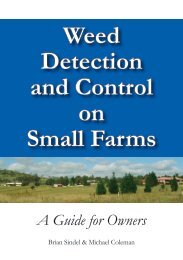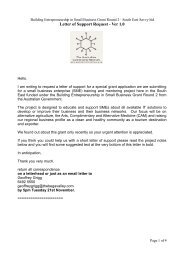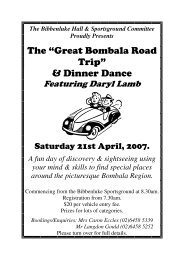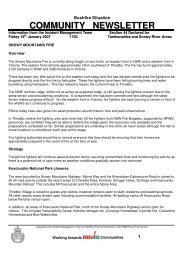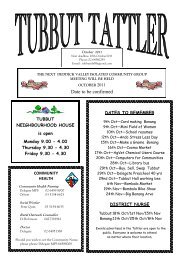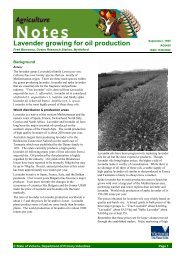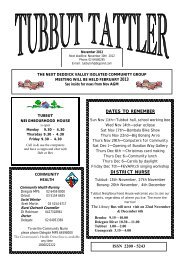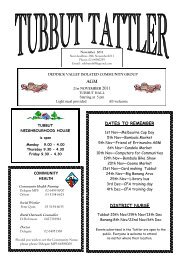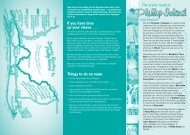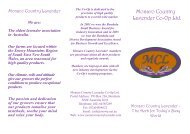COMMUNITY HEALTH DATES TO REMEMBER ... - Platypus Country
COMMUNITY HEALTH DATES TO REMEMBER ... - Platypus Country
COMMUNITY HEALTH DATES TO REMEMBER ... - Platypus Country
You also want an ePaper? Increase the reach of your titles
YUMPU automatically turns print PDFs into web optimized ePapers that Google loves.
AUGUSTBIRTHDAYSSharon BuckmanEleni McIlroyTom VentryBOMBALA WASTEMANAGEMETSeptic tank pump outsand disposalContact:Robert & Sharon Hampshire11 High St Bombala NSW 26320417423983 or AH 02 64583075Trailer for HireThe Neighbourhood House now has a trailer availablefor hire$5.00 per dayFor bookings phone64580295THEBOMBALA TIMES, SNOWY RIVER MAIL& DELEGATE DOINGSTubbut Neighbourhood House purchasesa copy of these newspaperseach week.Call in and browse the current editionsCONGRATULATIONSgo toTom VentryWho is celebrating his70th birthdayrobshaz10@dodo.com.auLibrary BusJust a reminder that the Library Bus will next bevisiting the area on 16th & 30th AugustBendoc 9.15—10.00Delegate River 10.30—11.00Tubbut 1.00—2.00Goongerah 3.15—4.00Card making Workshop(Adults & children over 10 years)9th SeptemberBonang Hall10.00am – 3.00pmThe tutor for this workshop will be Leslie Smith.Lunch will be supplied.A fee of $5.00 will be charged for this workshop.Please book earlyso we know how many to cater for.The Tubbut Tattler is produced by the Coordinators of the TubbutNeighbourhood House which is funded by the Victorian Government.Material herein is the responsibility of the authors and does notrepresent the views of the DVICG or Tubbut Neighbourhood Houseunless stated. We welcome material from, and of interest to, people inthe border areas of East Gippsland and NSW.
Essential Medical Equipment PaymentThe Australian Government announces Essential Medical Equipment PaymentAs part of its household assistance package, the Australian Government has announced an Essential MedicalEquipment Payment (EMEP) to assist people who have higher than average household energy costs because theyuse essential medical equipment, or medically required heating/cooling to manage their disability or medicalcondition.The EMEP can be applied for in several ways, including online from 18 June, or by contacting the Department ofHuman Services on 13 24 68 to request a paper claim form. The Department recommends people claim online asthose applications will be assessed faster than paper claims.There is also an online booklet containing detailed information about the EMEP.The Essential Medical Equipment Payment is an annual $140 payment to people who experience additional increases in homeenergy costs from the use of essential medical equipment to manage their disability or medical condition. Payments will startfrom 1 July 2012.You may be eligible for this payment if you or the person in your regular care at home: either holds or is included on one of the following cards: Health Care Card Pensioner Concession Card Commonwealth Seniors Health Card, or Department of Veterans’ Affairs (DVA) Gold or White Card; and provide proof that the specified essential medical equipment or medically required heating/cooling is required as a result ofa specified medical condition. This proof can be provided as: certification from a Medical Practitioner, or evidence that the medically required equipment (excluding medically requiredheating/cooling) currently qualifies for assistance under one of the state or territory government schemes, or the Department ofVeterans’ Affairs Rehabilitation Appliances Program.You may also need to prove that you, or the person you care for, contribute to the payment of the home energy account.The following list of equipment will attract an Essential Medical Equipment Payment. These items (except electric wheelchairs)currently attract subsidies under the various state and territory government life support equipment subsidy schemes. Equipmentnot listed will not attract an Essential Medical Equipment Payment. Home Dialysis Machine Home Ventilator Home Respirator Home Parenteral or Enteral Feeding Device Oxygen Concentrator Heart Pump Suction Pump Infant Apnoea Monitor – prescribed by a Medical Practitioner following apnoeic episodes Nebuliser – used daily Positive Airways Pressure Device Phototherapy Equipment Airbed Vibrator Electric Wheelchair Insulin PumpTo be eligible, the equipment must be powered by a form of energy that will increase under a carbon price. These forms ofenergy are electricity, natural gas, petroleum gas, diesel, heating oil, petrol or kerosene.If you have one or more of the specified medical conditions outlined below and as a result you medically require heating and/orcooling in the home to regulate body temperature, you may be eligible for the Essential Medical Equipment Payment.Spinal cord injury at or above the T7 levelStrokeBrain injuryA neurodegenerative disorderThe Muscular DystrophiesFull thickness burns covering more than 20 per cent of the body surface areaRare disorders of sweating including congenital absence or mal-development of sweat glandsChronic erythrodermas.You will need to apply for the Essential Medical Equipment Payment online through humanservices.gov.au/cleanenergy [1] andselecting the Online Services option. There will be no need to reapply in future years unless your personal circumstanceschange. To receive this payment, you will also need to be in Australia on the date that you apply for the payment and on theanniversary of this date in subsequent years. Dependent children are not able to claim this payment.http://www.humanservices.gov.au/customer/services/centrelink/essential-medical-equipment-payment
FEVA Pitch WORKSHOPSTubbut Neighbourhood House is delighted to be bringing you a series of workshops to bringour valleys alive … with the sound of music. FEVA Pitch, who some of you heard performingat Taste of Tubbut, is well known for its work with groups. Heather and Eva have the knack ofmaking singing fun, so that even people who say they can’t sing are amazed when they hearhow their voice sounds with other singers.Our first workshop with FEVA Pitch will be held at Bonang on Saturday September 1st at theBonang Hall. People of all ages are warmly invited to participate—it will be fun.We will learn a few songs and sing together accompanied by various percussion instrumentsand create our own song. The end result will be a performance piece for the Bonang concertin December. One more workshop will be scheduled for November, tba, and we will rehearseon the day of the concert. Please register your interest with the Tubbut Neighbourhood House.Bonang Hall, Sat Sept 1, 11 am—3.30 pm. Bring something toshare for lunchSinging WorkshopsEva & Heather have been teaching community singing workshops with various groups of people for over 20years. They teach songs from all around the world, from beautiful ballads through to uplifting gospel and upbeatAfrican songs.Eva & Heather have a knack for bringing a group of people together, regardless of their previous singingexperience, to have fun and create beautiful harmonies. They teach intricate harmonies and interesting rhythmsin a way that is inclusive and fun. Participants are delighted by the experience of being joyfully lead to createbeautiful, uplifting music together!“I couldn’t believe how great I felt coming out of that workshop! I was nervous going in, but Eva & Heather areso welcoming and supportive and confident it really helped me to let go and really enjoy … .just singing. Thedifferent songs were beautiful, so uplifting. I can’t wait for the next one!”Julie, workshop participant, Briagolong 2010“Every Community Has a Song to Sing” WorkshopsRecently, Eva and Heather have been fine tuning a project they call “Every Community has a Song to Sing”. Thisproject is one where a regular singing workshop becomes a catalyst for a group of singers to be supported towrite their own original community song. Through singing, discussion and having participants write down notesabout the legends, tales, challenges, stories and spirit of their community, Eva & Heather support them to createan original song about their community. A wonderful journey for a group of singers to share, and a powerful wayto acknowledge the history and strengths of our communities.PercussionEva & Heather have a wonderful Brazilian / African percussion kit and inspire workshop participants to createwonderful rhythms on a variety of instruments. The different rhythms Eva & Heather teach include: samba;reggae; rap; Los Percusos and more. These are fun and engaging workshops for all ages.
Needlefelting returns to BonangDue to popular demand, Jenny Romano is coming back to Bonang to give more people theopportunity to create magical and natural creatures by the amazingly effective technique ofneedlefelting. All materials are supplied and a fun day is guaranteed—and you leave with anawesome creation and the skills to make more.Jenny writes:I would love to do another weekend workshop inBonang. The one last year was so memorable Ihave relived it on several occasions andpromoted its success. Even to making a tiny redwallaby joey in a blanket!!!!In the latest edition of the Felt magazine I havean article about felting mice. I'll send you a copyof the article. Felted mice would be good. If weexpect the little ones like last year I wouldsuggest the bunnies as they are easy.We could also do another felted pixie for thepeople from Delegate who weren't able to takemy workshops recently. I can teach two differentthings as the procedure is the same.Just different dimensions, colour and wool types.I have just returned from the Bendigo wool showwhere I judged again. I won two second placeawards this year. The standard of the entries wasexceptional.Bonang Hall 10.30-4 pmSaturday September 15 thgnomes, pixies and other mythicalbeingsSunday September 16 thbush critters – mice, wallabies,whatever you fancy.Bring your lunch; children welcomeMaterials supplied, cost $5 per day(Bring your own foam and needle if you havethem)Please book at TubbutNeighbourhood House 64580295or tubbutnh@bigpond.com
Remembering Freda and FrankThis month we remember two former Tubbut residentswho passed away in recent weeks. Although it’s a longtime since they lived here, their years at Tubbut left theirmark on our community and was an important period intheir lives.Freda HortonFreda was born in the central NSW town of Condobolin onthe 16 th May 1931. She was the eldest daughter ofFlorence, known as Toss, and Arthur Hurley. She lived atKeirin Hills station near Condobolin with her parents andyounger brother Bill and sister Laurel until marrying at theage of 20.Freda commenced school at ‘Kerein Hills” in a tin shed onthe property where the family and other local childrenwere taught by a governess. The school closed when shewas 7 or 8 and she was taught correspondence by hermother until the age of 12 when she went away as aboarder to a convent in Forbes and later to ClairmontLadies College in Sydney. Apparently she had to attendboth a Catholic and Church of England school to appeaseher two grandmothers!After finishing school Freda returned home and becamethe postmistress. She also ran the telephone exchangewhich was set up at “Kerein Hills”. All telephone calls inthe district came through the exchange and it was Freda’sjob to manually connect the calls.David first met Freda when she was 17 years old and heand his brothers were droving sheep in the district. Theycalled in at Kerein Hills for a cuppa and Freda remembersthat when she entered the room he stood up.….alwaysthe gentleman! She told us that David was very good toher parents and they actively encouraged the relationship.David found ways to stay in the area, droving and shearingover the next years, we asked why and he said it wasbecause Freda was chasing him – sounds like he wantedto be caught. They purchased a property which had 2houses and set about preparing the better of the housesto live in after their marriage. They painted the house andfurnished it so that they could move in after the wedding.Unfortunately, 6 days before the wedding a fire destroyedthe house.They were married on the 16 th of January 1952 in Orangeand had a honeymoon on the NSW South coast. Whilethey were enjoying their honeymoon they received amessage to say that a bushfire had burned near theirproperty and the fire fighters had emptied their stocktanks leaving the sheep with no water. They had to returnimmediately and take the sheep straight ontothe road to save them from dying of thirst soFreda started her married life as a drover….notreally what she had in mind!Freda and David have been married for over 60full, busy and eventful years. They had 5children, Lesley, Scott, Toni, Stuart and Brett, 9grandchildren and I, soon to be 2 greatgrandchildren. There has been much happiness,many memorable parties and some tragedyand deep sadness due to the death of theiryoungest son Brett at the age of 24.They spent the first 9 years of their marriage inthe Condobolin district and in 1961 theybought a farm at Tubbut in far East GippslandVictoria. They piled children, furniture, chooks,a cat and all worldly possessions into an oldblitz truck and set off for Victoria. Fredathought that the chooks needed to stretch theirlegs so she let them out for a run at Bredbo,near Cooma and there was much effortexpended in gathering up the chooks.On arriving in Tubbut late in the day they drovepast the tennis court and as they got closer tothe house (now the home of the Auer family)
they noticed a line of headlights following them. Thewhole area was there, they unpacked the truck,provided dinner, lit the fire and made up the beds. Overthe next six years, this closeknit community provided thefamily with support, friendship and some exceptionallylong parties. For example, New Years Eve parties startedwith the dance at Bonang and ended eventually after 2or three days at McKillops Bridge for more celebrationsand swimming. Not that Freda was much of a swimmer,in fact her fear of water was such that when walkinghand in hand with David in the Lachlan River she walkedoff the edge of a sand bar and according to Freda shewalked along the bottom, - “not according to theamount of skin I lost,” said David.In 1968 they sold the farm and moved to the GippslandLakes so that the children could attend secondaryschool. They then embarked on a series of differententerprises from establishing the scenic binoculars inLakes Entrance, opening a commercial laundry, buildingand running a public aquarium, motel management andentering the fishing industry.David commenced work in the Bass Strait oil industryand Freda managed home, business and family. Brettclaimed with much truth to have been raised on anironing board in the laundry.It was in Lakes Entrance that Freda developed a passion,some may say obsession, with collecting antique bottlesand Australiana. Weekends and holidays were devotedto bottle collecting which meant scouring old tip sitesand lots of digging. Freda enjoyed not only thecollecting but the competition. She was an activemember of the bottle club and won many Australiannational show trophies. The social side of the bottle clubwas just as important and members have ensured manyfinds for future collectors. As the kids got older andFreda lost her labourers she went on to collect Avonbottles and justified the expense by giving every memberof the family Avon – without the container. Thingsimproved for the family when Freda tired of Avon andcollected ceramic Jim Beam bottles. She had one of thebest collections in the country and continued tocompete at a national level.In 1982 they purchased Craig Gowan Station atHinnomunjie and returned to the life of the sheepstation. The older children had left home by this time butStuart and Brett went with them. Freda rescued somany lambs who were brought home to bepoddied...that meant sleeping in the loungeroom at firstand then progressing to an outside shelter lined withelectric blankets. These lambs, including Lipstick, Penciland Milkshake would follow Freda around theproperty.Freda and David had many visitors and theirreputation for hospitality, fantastic chocolate cakesand great parties continued. Freda was also a keenmember of the Benambra CWA - a position onlyfor the brave. One memorable meeting saw herheading off dressed in brown skivvy, panty hoseand a tail to fulfil her role as the goat in OldMacDonalds farm. As always life was full, David onan oil rig, thousands of sheep, dogs, cats, kids – astint at the Arlberg ski resort for a 3 monthcontract and a new area to dig bottles in.At the end of the 1980’s they decided to retire sosold the property and moved to Lake Bunga.Retirement didn’t last long as a year or so laterthey purchased the building which became theRiviera Trading Post which they ran until 8 yearsago.Everyone always came to Freda and David’s home.You would always be welcome, well fed andexceptionally entertained.Thanks to daughter Lesley Edwards for providingthe eulogy and photograph below and to HelenNeven for the photograph on the previous page.Those of us who didn’t meet Freda feel we reallymissed something.Freda, early 1990s.
Frank KellawayPoet, bird and music loverdied Friday July 13, 2012.His family would liketo thank the Brotherhoodof St Laurence for their compassionate care and kindness.Rest in peaceCarlotta, Dan and MariaThe Age July 17 2010Photograph downloaded from http://illuminatiguzzisti.forumcircle.com/viewtopic.php?t=22727&postdays=0&postorder=asc&start=15An interview with Frank about his poetry can be found at http://www.nla.gov.au/ms/findaids/7071.htmlRemembering FrankMy most vivid memories of Frank’s time in Tubbut arehis meals and his dogs. The dogs were very large andshaggy. They seemed to be totally untrained so whenFrank stopped the car and went to open the back doorthe dogs would be clawing at the windows. As Frank wasdeaf, he wouldn’t hear us saying “Keep the dogs in untilwe tie ours up.” So the dogs would be out the door andstraight away attacking our dogs. Woolly would give asgood as he got. The next morning his head was swollenas it had been completely inside the other dog’s mouth.A trip to see Steven Reed in Delegate and soon all waswell.An invitation to dinner with Frank and Carmel was ahighlight. They were both good cooks. I remember agreat meal of abalone, so tender and creamy. And ahuge saucepan of the most delicious and flavoursomepumpkin soup. Frank’s staying power was short so hewould often go to bed soon after we had eaten. But if hehad planned a poetry reading he would stay up and readus some of his work. His observation of wildlife wassuperb and he was willing to teach us. He took uppainting in oils in his later years. He was a man of manyparts and very creative.Valerie AuerFrank Kellaway (1922– 2012), born London of Australian parents,graduated from the University of Melbourne in 1948 and workedas a librarian and as a lecturer at the Preston Institute ofTechnology in Melbourne. His volumes of poetry are Beanstalk(1973) and Mare's Nest (1978). He has also written fiction, AStraight Furrow (1960), The Quest for Golden Dan (1962) andGolden Dan (1976), and verse libretti for the music of GeorgeDreyfus in operas performed in Australia and abroad. He won firstprize in the inaugural National Poetry Competition in 1986.Read more: http://www.answers.com/topic/frankkellaway#ixzz21mOhzWHdIt was by accident that I learned of Frank’s death; googling afterlocating him on the National Library’s Trove site, I found anobituary page in The Age. Too late to interview him. Using goodold Google again, I found Frank’s son Dan who now makesclassical guitars an hour from Scone. During a long friendly phonecall he brought me up to date on Frank’s life post-Tubbut.Frank Kellaway and Carmel Saville moved to Tubbut in the late1970s and were part of our social and cultural life until 1988.Frank enjoyed good food and drink and loved sharing meals withfriends. For a while he hosted a writer’s group which must havetried his patience as we were such amateurs and writing was hislife. We may not have been fully aware of his literary reputation.The excerpt above from the Oxford Companion to AustralianLiterature reveals how he will be remembered by the world.Frank retained a close friendship with Oliver and Fran Gasperini,who purchased land on Willis Road/McKillops Road, which lasteduntil he died. At one time, Frank lived in a 4 metre by 4 metre hutthat Oli built him on their Stony Rises property. Furthermore,Carmel remained his close friend and helper although theirintimate relationship ended before they left Tubbut.In his last couple of decades, Frank found painting to be morelucrative than poetry. Dan bought him a Hiace van fitted out as acamper which he reckons Frank drove around Australia 15 times.As he went, he painted, and his naïve landscapes sold for around$100 at exhibitions. Because he was prolific, he was able to makeenough from sales to finance the next trip, and so it went.According to Dan, Frank never learned how to change a sparkplug or even a tyre, sitting by the roadside until a consideratemotorist passed when he got a puncture.A couple of years ago, Frank was close to death in hospital. Hedidn’t want to be brought back to a second-rate life and asked forthose wishes to be respected. After emerging from a coma,however, Dan reckons that he ‘lost the will to fight for the right todie’ and recovered, to ‘go downhill’ as he tried various livingoptions. Not an easy person to live with, he tried some friends inDarwin, followed by Dan’s place (then near Singleton) where hewore out his welcome. After a stint in a ’terrible place’ for old folkin Melbourne, he found himself a bed at Sambell Lodge in CliftonHill run by the Brotherhood of St Lawrence where he was lookedafter exceptionally well. Twice he suffered breakages—the firsttime he tried to die with the help of a taxi outside the Lodge butbroke a leg instead. His death resulted from infection aftersurgery to fix a femur broken in five places. His memory was atlong last failing him; it was time to go.Frank sold his letters to the National Library, as he correspondedwith many famous Australians such as Manning Clark, JudithWright, Gwen Harwood, Stephen Murray-Smith and Ken Inglis.(see http://www.nla.gov.au/ms/findaids/7071.html for acomplete list of his papers).Deb
The Cabanandra-Avonleigh PlantationsFrom the road, nothing seems to have changed in theplantations on McKillops Road apart from a missing gate at themain entrance near the former house. In fact, a great deal hasbeen happening although the effects of these changes are notyet visible.When Willmotts was put into receivership /liquidation inSeptember 2010, management of the plantations went intolimbo. Gates were opened to ensure access for emergencyvehicles and weed and other pest control ceased. There wasno maintenance of firebreaks, declared noxious weeds, fencesor other infrastructure, although some locals say there waslittle enough of that when Willmotts was solvent.The job of selling Willmotts’ assets went to liquidators PPBAdvisory. The process was slowed by a court action fromWillmott Action Group (WAG).“Investors who pumped about $150 million into forestryschemes run by the failed agribusiness group Willmott Forestshave launched a class action against the company, itsdirectors and the Commonwealth Bank. In court documentsfiled in the Federal Court …, lawyers for the investors havealleged that documents spruiking three forestry managedinvestment schemes failed to disclose all the risks attached tothe investments.The investors have also alleged that Willmott overstated thevalue of assets including land and future wood sales andunderstated its liabilities '’by failing to provide for the cost offuture plantation maintenance work’''.http://www.smh.com.au/business/forestry-group-faces-classaction-20111223-1p8fu.html#ixzz21h4NuGTkThe judgement of the Federal Court failed to fully satisfy WAGwhich launched an appeal against the February decision. Thelatest news on the court process is bad news for WAG: thegroup has been ordered to pay the legal costs of theliquidators after Justice Davies’ decision on June 27 th thisyear.WAG explained its reason for its appeal against an earliercourt decision as follows: “The WAG Executive is of the viewthat what is happening so far is an improper and courtendorsed transfer of wealth from investors to Banks (andothers) and this cannot be allowed to be successful if at allpossible. There are, in our view, a host of improper andunconscionable conflicts between banks/liquidators/courtofficials/lawyers/Forestry Players all to the detriment ofgrowers WHO HAVE DONE NOTHING WRONG IN THISWHOLE PROCESS AND WHOSE INVESTMENTS WERENEVER IN LIQUIDATION.” (Capitals in original on WAG’s website) http://www.willmottactiongroup.com/Action_updates/actionupdate21042012.htmlWhile WAG was fighting in the courts, another group callingitself Willmott Growers Group (WGG) was negotiating to retaincontrol of those plantations planted for them by Willmottbetween 1996 to 2000, in hope of recouping some of theiroriginal investment.“It is WGG’s view that, with the collapse of Willmott ForestsLimited (WFL), the Project is no longer being adequatelymanaged. In order to restore the Project as close as possibleto its original status, it is necessary to appoint a newresponsible entity (Trustee) and also to provide amechanism whereby ongoing and future maintenanceand management costs will be funded by Growers.Converting the Project to a contributory scheme is thebasis of the WGG Proposal. In addition, there will bean initial management fee to pay for the costs ofsaving the Project as well as to cover any requiredforestry remediation costs.”Their efforts resulted in the appointment by CourtOrder in late-December last year of Primary SecuritiesLtd to manage the Willmott 95-99 Project, the Treerights for almost 5000 hectares of their plantationtrees, though management really only becameeffective from early April this year. The Cabanandra-Avonleigh plantations make up 20% of the total.Primary Securities is the ‘responsible entity’ (Trustee)managing the land on behalf of the lessee Treegrowers.John Byrne, a forester from Bathurst NSW, iscontracted by Primary Securities Ltd to provide theday to day management of these particularplantations. [Note that the growers only lease the landon which the trees are growing, for 25 years from theirplanting date, but not the actual land. on which thetrees are planted. There are, however, moves afoot totry to purchase the land from the Liquidator.The balance of the Willmott Forests’ of the Bombalaregion plantations – 10,000 hectares – both land andtrees - is now owned through Global Forests PartnersLP which has set up a new company called SnowyMountains Forests. Most of those plantations wereestablished between 2000 and 2008, though GFP alsonow owns a number of the older Bendoc plantations.I recently spoke to John Byrne who tried to make thecurrent situation clear to me so that I could report inthe Tubbut Tattler. He has been down to look at theAvonleigh/Cabanandra plantation twice this year, andplans to be in this region again for a week from August12th. He tells me that there have already beenenquiries from neighbours adjoining the 95-99 Projectplantations. Primary Securities will not be taking onemployees at this stage; all work initially will beperformed by contractors. A contractor has alreadybeen hired to slash the perimeters and major roadswithin plantations, but wet weather has delayed thiswork. Weed-spraying, particularly on the boundaries,has also been arranged. Issues like fencing are out ofhis ambit however, and should be reported directly tothe landowner (currently PPB Advisory).John Byrne will be available at the Tubbut CommunityCentre from 4pm to 6 pm on Thursday 16 th August toprovide additional information and answer yourqueries.Information for this article has been taken from theweb sites of WAG, Primary Securities Ltd and theSMH. Thanks to John Byrne for his time in providinginformation and checking its accuracy.Deb
Bits & PiecesWe’d like to introduce you to Sheilas – an exciting newinitiative of the Victorian Women’s Trust. Sheilas is amonthly, national e-publication. We unpack news andinformation through quality analysis by top shelfcontributors. Each issue will cover topics relating toAustralian women alongside some excellent writing onsocial issues at large. We also throw in some arty fun justto keep you entertained!To visit Sheilas, follow this link: http://sheilas.org.au/We would also like to offer you a free subscription toSheilas. This includes monthly email access to each edition,and a monthly round-up of outsourced relevant news linksbetween editions via our Sheilas Monthly Mail. Tosubscribe, type in your email address at the top of thehomepage (you are free to unsubscribe at any time, simplyby clicking the link at the bottom of your Sheilas mail).Spread the word to friends and associates! If you areinterested in supporting the initiative further or have anyquestions, please email Sheilas editor Sarah Capper:sarah@vwt.org.au, or call the VWT on (03) 9642 0422.Writers, Contributors and Photographers Please Note:We welcome contributions and can offer payment oncertain pieces. If you have an idea for an article, pleasesend us an email at sarah@vwt.org.au.Photographers of all persuasions should check out theKeeping it Reel section celebrating ‘Pictures of You’ – thelived experience of women. If you wish to submit a photofor publication, please email us at sarah@vwt.org.au.Grazing management project at JarrahmondAn exciting project is commencing in Gippsland that willsupport the farming community gain practical knowledgeon the impacts of different grazing regimes through agrazing management demonstration.The 48 acre site is at Peter and Jeanette Honey’sJarrahmond property as they, along with many otherfarmers, are keen to understand whether changing grazingmanagement systems will better protect and enhance theirsoil and pasture assets, improve productivity and befinancially viable in this region.The project will be focused on two identical sets of threepaddocks. Set stocking will be compared with a mediumrotation and a longer one. The aim is to examine theimpact of different stocking rates and grazing lengthperiods in relation to pasture recovery time, feed qualityand total production.One block of three paddocks will be top-dressed accordingto soil test data and the other left un- treated. Data will begathered from the soil and pasture to test for any changesand the economics involved in adopting differenttechniques will be examined.Regular field days will be held on the site, with the first oneplanned for September. If you would like more informationcontact stuclarke@y7mail.comFriends of Errinundra working beeI would like to express my thanks to those who wereable to put aside some time to help with the installationof the Delegate River Campground info shelter lastweekend (July 14-15). I was quite pleasantly surprisedby how easily the structure went together.After a long day’s work on Saturday we had thestructure erected and the concrete footings poured andthe only job remaining was to put the roof on.I was able to go out the following day with my father(does this make him an honorary member?) and screwthe roof on so that the timber will be somewhatprotected from the elements until a second coat of oilcan be applied.David Butterworth, Parks Ranger_____________________________________________Aust Post, farmers team upFRUITS and vegetables will be delivered fresh from thefarm to the consumer's doorstep in a new Australia Postprogram. For the first time consumers will be able tovirtually `meet' various farmers, see their farm and buytheir produce at their prices through the internet, PerthNow reports.Australia Post's pilot paddock to plate venture is calledFarmhouse Direct and marries the country's largestdelivery network - servicing close to 10.7 millionaddresses every day - with local producers.The promise is to connect "you directly to the best localproduce'' and make local farmers markets and "artisan''produce an everyday experience, Australia Postcommunications manager Melanie Ward said.The pilot program started out as a collaboration withthe Victorian Farmers' Markets Association this year butits popularity has led to a national rollout involving 70producers and 680 products so far.Australia Post has set up a website - atfarmhousedirect.com.au - where farmers set up shopfor free and set their own prices. Users can explore thewebsite by region, product, produce and even by localfarmers markets like the Flemington Farmers Market toorder online.Farmers prepare the shipments, which are either pickedup by Australia Post from the farmer or handed in to adepot, and Australia Post looks after the delivery."It's an exciting project for us. Still in its early stages, butthe popularity has been overwhelming,'' Ms Ward said."These days it's important to set up an online presenceand we are helping some of the local smaller businessesdo that at no cost. The producers are the heroes.''An official launch of the program is expected towardsthe end of this year.http://www.weeklytimesnow.com.au/article/2012/07/17/510941_business-news.html
News from (and about) the DepartmentsIllegal tree felling causes concernDSE media releaseAuthorised Officers from the Department of Sustainabilityand Environment (DSE) undertaking routine patrols areobserving a high number of illegally felled trees in StateForests across Gippsland.DSE Senior Compliance Officer, Peter Simpson said thiswas a cause for concern, particularly as some trees havebeen felled onto, across and next to busy major roads,with trees left hanging and leaning dangerously againstother trees.“This obviously poses a major public safety risk to roadusers, other users of our State Forests and to the DSEstaff who have to ensure these trees are dealt withproperly and safely.”“The trees felled are dead mature trees that provideimportant habitat for our native wildlife, particularly ourowl species.”It is illegal to cut down standing trees for firewood or anyother purpose. Only fallen timber can be collected in thespring and autumn seasons and people must notdamage, disturb or destroy any wildlife habitat such ashollow logs and dead or living standing trees.“Felling and removal of timber in State Forests isgoverned by the Forests Act 1958, and under this Actserious penalties apply,” Mr Simpson said.“The maximum penalty for illegally felling, cutting orremoving forest produce is a fine of up to $7,042 and/or12 months imprisonment for each offence under theVictorian legislation.”“People who harvest firewood illegally don't hold theappropriate licences and pose a public safety risk, asthey are not qualified to operate equipment utilised incommercial firewood harvesting."I urge anyone with information about this type of activityto report it, as it's having a significant impact on our Stateforests across Gippsland."You can report environment, wildlife and forest crime toDSE on 136 186.The next opportunity to collect firewood from public land,for personal use only, will be the commencement of thespring firewood collection season on 1 September 2012._____________________________________________THE Victorian government is taking the environmentbackwards, according to Environment Victoria.Broken promises, poor vision and an inability to listen tothe public are behind the decline, the state's peakenvironmental lobby group says.A report by Environment Victoria says the Baillieugovernment, in its first 18 months in power, doesn'tconsider environmental protection a priority and has noclear plan to tackle declining biodiversity, climate change,unsustainable water use and Melbourne's urban sprawl.Environment Victoria CEO Kelly O'Shanassy says thereport referenced a poll of 1000 people, which found thatthe government was out of touch with the environmentalinterests and attitudes of Victorians."Victorians want liveable cities, not urban sprawl," MsO'Shanassy said in a statement."They want the government to make decisions thatenhance the natural environment and ease the pressureon the cost of living."But the government's decisions are taking us in theopposite direction."Out of 57 significant environmental policy commitments thegovernment made ahead of the 2010 election, it had so fardelivered only five in full and already broken three, the reportsaid.The report, entitled Victoria's Environment: A State inReverse, also attacked the government for scrapping alegislated target of a 20 per cent reduction in greenhousepollution by 2020, reintroducing cattle grazing in the AlpineNational Park and axing plans to phase out the Hazelwoodcoal-fired power station.Its survey found that 78 per cent of Victorians want to seemore investment in renewable energy and 63 per cent wantfewer coal-fired power stations, but it says the governmenthas made wind farms harder to build and solar power moreexpensive.http://www.weeklytimesnow.com.au/article/2012/07/31/517211_latest-news.htmlFind out about planned burning in EastGippslandThe Department of Sustainability and Environment (DSE)has updated the local Fire Operations Plans for the nextthree years and they will be on display for public viewing andcomment at DSE and Parks Victoria offices across theregion from Wednesday August 1 until Friday August 312012.Gippsland’s Fire Prevention Coordinator, Alison Kerr saidthe draft plans show where DSE and Parks Victoria intend tocarry out planned burning and other fire prevention activitiesto reduce bushfire risk to people, property and communities.“In the Orbost fire district, significant burns are planned inthe Orbost, Wulgulmerang, Gelantipy, Tubbut, Genoa,Bendoc, Mallacoota, Bemm River and Cann River areas.Many of these burns will build on strategic works completedin previous years.”The burns aim to reduce bushfire risk for strategiccommunity protection, larger landscape protection and forecological and regeneration purposes.“In developing these draft plans, we’ve been talking to localcommunities and key stakeholders such as Parks Victoria,CFA, beekeepers, winegrowers, local tourism operators,environment groups, and local Aboriginal Corporations.”Local communities are welcome to get involved in fireoperations planning throughout the year and areencouraged to come and talk to DSE staff at any time if theyhave comments or questions.“We do our best to reduce the impacts of burning oncommunities and stakeholders, but ultimately the decision toburn is always driven by the need to reduce the risk ofdamaging bushfires.”Ms Kerr said timing of planned burns depends on theweather and other conditions, such as how dry the fuel is.“The Fire Operations Plans are designed to be flexible so wecan respond to changing weather and conditions, and burnscan be carried out at any stage over three years when theconditions are right,” she said.The 2012-13 planned burning program for Gippsland is justunder 98,000 hectares. DSE and Parks Victoria are aimingto complete 250,000 hectares of planned burning across thestate if weather and other conditions are suitable.In addition to visiting DSE or Parks Victoria offices in person,you can also see the Fire Operations Plans for your area atwww.dse.vic.gov.au/burns If you would like to speak tosomeone about planned works near you, or view andcomment on the draft plan for your local area, contact theOrbost DSE office on 5161 1222.
Soon after their return from World War 1, Colin Hume ofWulgulmerang and Keith Rogers of Black Mountainwere given the job of delivering a boat to DuncanMcKellar on the Snowy.The Shires of Tambo and Orbost paid McKellar to live onthe Snowy, about one kilometre upstream from wherethe bridge is now situated, on the eastern side. His jobwas to ferry people, travelling the old Gippsland track,across the river in his boat. People travelling from westto east, when nearing the river, would yell out and cracktheir whips to attract his attention whereupon he wouldrow across to pick them up. He would them row themover the river with their horses swimming behind theboat.However, a flash flood in the Snowy took his boat, hencethe need for a new one. The new boat was brought toWulgulmerang by bullock wagon. It was then Colin andKeith’s job to take it from there onto the Snowy.The boat was loaded onto a spring cart pulled by horseswhich was driven to Wheeler’s Saddle. At that time,there was a road suitable for horse drawn vehicles downto Royal’s Camp. At Wheeler’s Saddle, they unloadedthe boat from the cart and put it on a sledge, which Ibelieve must have been made on the spot out of aforked tree. After securing the boat to the sledge andyoking the horses to it, they snigged it along the ridgefrom Wheeler’s Saddle then down the very steep, rockyspur to the river.How they got it down in one piece without it tippingover and rolling down the side, taking the horses with it,I don’t know!I presume they then took the horses back up toWheeler’s Saddle, harnessed up the cart and drovehome. “Job completed.”Spirit of the SnowyDelivering a boat—Buff RogersCrossing sheep over theSnowy—Buff RogersDuncan McKellar had his punt and the water was quieterand slower. There they would build rough wings in the formof a “V” going into the river. The wings would be built out offallen trees, limbs, scrub etc. Occasionally hessian was usedas some sheep drovers carried hessian on their packhorsesfor holding their sheep at night. The sheep would then beforced into this “V”. Whoever was a good strong swimmerwould strip off, grab a sheep, tie a dog chain around its neckand pull it into the river. The strong swimmer would thentow this animal across the river. Hopefully, with muchpushing and urging from both men and dogs, the rest of themob would plunge in and follow. However, thois processhad to be repeated many times as sheep are notorious forringing in the middle of the river and coming back on thewrong side! The sheep that did cross, of course, had to beheld on the western side by somebody until the whole mobcrossed over.Crossing mobs of sheep was a long difficult job that requiredmany hands. A large mob would take a couple of days tocross. When this task was completed, the sheep would thenbe driven up the long , steep spur to Wheeler’s Saddle andthen onto Wulgulmerang.Occasionally a mob of sheep that had been walked downfrom Bombala or Delegate would arrive at the Snowy only tofind it was too high to cross. In this situation, the sheepwould have to be shepherded about for a few days or up toa week until the water level dropped to allow safe crossing.What a blessing the new bridge must have been!These stories are taken from Spirit of the Snowy, a shortstory collection to mark a Snowy River Journey, 1st to 3rdNovember 2002. A copy of this publication, edited by G.Enders and published by the NSW Premier’s Department onbehalf of the organisers of the inaugural Snowy RiverJourney, November 2002.During the years after the first world war until the secondbridge was built across the Snowy River at McKillopsCrossing in the 1930s, my family was involved in crossingmobs of sheep over the river. These sheep were bought onthe southern Monaro and w3alked to the family propertiesat Wulgulmerang and Black Mountain, or continued downto be resold in Gippsland.I believe there is a photo of my father, who was a verymodest man, standing on the bank of the Snowy, starknaked except for a dog chain hanging around his neck.What has this got to do with crossing sheep you may ask?This is how it worked: the sheep, which would be in mobsof between two to four thousand, would be crossed overthe Deddick River and taken up the Snowy to whereBuilding the Snowy River Bridge—1932. From Sandy Cameron’sphotograph collection.
Bits and PiecesEl Nino to returnLyndal Reading | July 3, 2012THE two words many farmers dread are back on thelips of meteorologists - El Nino.The Weather Channel is predicting a move to the dry ElNino pattern after two years of record rainfall.Senior meteorologist Tom Saunders said climatemodels were indicating an El Nino weather pattern wason its way.He said sea surface temperatures through the centraltropical Pacific Ocean had gradually warmed during thepast few months and were now more than 0.5C aboveaverage, passing the threshold for El Nino conditions."Extensive warming through the Pacific Ocean causesa major shift in weather patterns throughout the worldand for Australia, causes below average rain anddrought like conditions,'' Mr Saunders said.He said El Nino conditions typically brought belowaverage rain and above average temperatures to theeastern half of Australia during winter and spring.Bureau of Meteorology climate meteorologist Dr HarveyStern said while climate models were currently neutral,there could be a move towards an El Nino later in theyear.————————————————————————--There is no doubt that wild dogs are a real problem tofarmers in our area and that many are at their wit’s end,wondering how to protect their sheep. The following article isincluded in the interest of having all the information includedin the discussion.DebCamera doesnʼt lie: farmersays dog bait is a failureBy MARK MULCAHY July 7, 2012, Border MailBURROWYE farmer Noel Cheshire was sceptical aboutthe success of baiting for wild dogs and wanted firsthandconfirmation about their eating habits.He knew the best way to have such proof was to set upcameras in the bush.Mr Cheshire, a previous member of the North East wilddog advisory committee for nine years, receivedfunding from Meat and Livestock Australia and aVictorian government department.He enlisted the expertise of his son, Wayne, and threemotion sensors for a camera were set up in the bush.Two remote infra-red sensors were set up about 20metres from the camera and another at its base.The cameras operated for almost two years with plentyof footage obtained.Baits used by departmental dogmen without any poisonwere buried and none of the wild dogs showed interest.The baits were then put on top of the ground and thefootage revealed foxes and pigs would take them butwild dogs walked straight past.Mr Cheshire and his son found a road-killedkangaroo and took it to the camera site.They put some bark over it and three dogs sniffedaround it before walking away.The footage showed one dog tentatively walkingtowards the kangaroo and then backing away.A second dog circled around the kangaroo and thethird went around in a half circle.Both Mr Cheshire and his son believe the dogsstayed away because of human scent or theyrealised there was something different to when theypreviously passed that area.“They are extremely cunning and wary,” WayneCheshire said.“If they will not touch a kangaroo, there is absolutelyno hope of them taking manufactured baits.”The Cheshires also have footage of four dogs goingpast a bait station set up by one of the dogmen neara tree.One dog went to the tree, smelt it and stood straightover the bait, but walked off.Pigs arrived at the same bait station and a boar dugup both baits with his snout and ate them.The footage was shown to politicians at Bill Tilleyʼsoffice some time in 2007.Attempts from within government departments havebeen made to discredit it, but the Cheshires andother farmers say the footage speaks for itself.Community feedback showed overwhelming supportfor the innovative camera project._________________________________________Firewood or regen burn?The torching of hundreds of tonnes of wood byVicForests upset farmers near Wallagaraugh whowere negotiating to collect the wood as firewood.Locals say logs good enough for timber products –known as sawlogs – were not removed from thesite, instead being pushed into piles and burned.And a local firewood business is fuming - it saysbetween 400 and 600 tonnes of logs it wasnegotiating to buy have been reduced to ash.Locals say logs good enough for timber products –known as sawlogs – were not removed from thesite, instead being pushed into piles and burned.http://www.weeklytimesnow.com.au/article/2012/06/22/499661_latest-news.htmlElsewhere in the Tattler is a media release from DSEregarding the illegal removal of firewood from stateforests. Logic would suggest that this article and the DSEconcerns are two sides of the same issue—perhaps adialogue between VicForests and DSE is in order.Deb
You are not aloneThe Age July 23, 2012Michael ShortThe Australia Institute recently published a report calledAll the Lonely People (obviously a Beatles fan was itsauthor).''If you have been lonely for three years, it is likely toextend for a long period of time. So yes, transitioning inand out is something that appears to be part of theexperience of life and is certainly going to be informed byevents in your life that you're not always going to havecontrol of. But once you find that you are entrenched orstuck in that experience, then that's where it is going tobecome a really important social issue.''In the report we cite a definition of loneliness that it isthe mismatch between the relationships that we desire orwish we had and the reality we are currently living. So forall people the experience or threshold for loneliness isgoing to be different, but for everyone it is a matter ofrelational voids in our lives.''Some of the key findings of All the lonely people are:■This risk of loneliness is greater for couples living withchildren than for childless couples. Baker speculates thisreflects the amount of time, energy and money it takes toraise a family.■People living alone or in single-parent households aretwice as likely to be lonely as people living in couples.■There is no difference in loneliness levels in cities andrural areas.■Young women who are on low incomes are the mostlikely group to be lonely.■Once people reach a minimal level of financial security,rates of loneliness are not affected by wealth.■For both men and women, increased financialdifficulties are related to becoming lonely.■During the 10 years to 2010, more men (36 per cent)were lonely than women (29 per cent). Baker believesthis is because women tend to nurture stronger socialnetworks. ''It is cliched, but men do not reach out to othermen.''■The prevalence of loneliness increases for men untilthe age of 60, but then declines.■For people aged 25 to 44, men are four times as likelyas women to live alone, and are twice as likely to belonely.■The role of social media is not straightforward. Somelonely people seem to be seeking social support throughnetworking sites, but do not consider such contacts realfriends, while those who are not lonely are using thesites to expand already robust social circles.Baker argues there are some policy implications forgovernments, particularly the need to provide support forpeople who leave hospital and have no family or friendsto help with the transition back to their normal life.''If you don't have that social structure, and the state isno longer providing sufficient resources, then there is abig issue there.'' Policies that promote employment arealso crucial, he says.But connecting to the community is the most accessibleway to combat loneliness. There are so manyopportunities to engage with people, places, issues andideas; Australia has more than 600,000 not-for-profitorganisations, employing one in 12 of the workforce andwelcoming as many as 6.4 million volunteers.Health NewsThere is, however, a paradox.''Our research found though that people who areexperiencing loneliness are less likely to volunteer, so thatthe option of using volunteering to help people who arelonely becomes more difficult because they are alreadymore hesitant to participate in volunteering.''Perhaps another ready solution lies right next door;connecting with your neighbourhood. These days,dropping in unexpectedly on family and friends hasbecome almost a faux pas, which probably reflects thedemands of juggling work and the afore-mentionedrealities of raising a family.But, given the persistence and prevalence of loneliness,surely it's time to question the wisdom of such hesitancy.Turning up unannounced might provoke offence ordiscomfort, so maybe it's not smart to just start barging inon people, but it would seem a decent idea to arrange,even at short notice, a bigger number of informal visits tofriends and family and neighbours.And, of course, we can circumvent the dropping-in issue byinviting people to our homes or some other venue. Thismight all sound rather evident, but it does not seem to behappening as much as it might.Almost all of us have been, or are, lonely or knowsomeone who is in need of, or even desperate for,company. How common, indeed, is the lament: ''I reallymust get around to catching up with X.'' Sometimes themost ingrained problems have simple solutions.Let's just make the effort and share the rewards.Read more: http://www.theage.com.au/national/you-arenot--alone-20120722-22i3d.html#ixzz21hXMR3fCEngaging with one's communityhas health benefits25.07.12There is strong evidence of the relationship between socialisolation and health. Older people who are socially isolatedare more likely to have poorer health in general, whileisolated adolescents are more likely to experience mentalhealth issues, show depressive symptoms and have lowerself-esteem.I would like to suggest that any readers feeling vulnerableas a result of social isolation should try to re-engage withtheir communities in ways that have been proven to haveboth mental and physical health benefits.Arts and cultural activities create opportunities for peopleto expand their social networks and to develop newfriendships, which can provide social support and impactpositively on health.Another way to engage socially is through activeparticipation in physical activity, which also has hugemental health benefits and is known to reduce depression,stress and anxiety, and improve self-confidence, selfesteem,energy levels, sleep quality and the ability toconcentrate.Participation in arts or physical activities are just two wayspeople can use to improve their mental health. There aremany others.One of the best things people can do when it comes tosocial isolation is to speak to someone about it.Jerril Rechter—Chief Executive OfficerVicHealth (Victorian Health Promotion Foundation)
L O C A L G O V E R N M E N T N E W SEAST GIPPSLAND SHIRE COUNCILThe group who met to prepare the draft communityplan has almost completed its job after a meeting onJuly 18th to consider the suggestions that you made toimprove the Plan. Thank you so much to those whomade comments.Brian Greer, our facilitator, will see the Plan through toits printing at Black Rainbow and then bow out. Hisinput was very helpful and our thanks go to him formaking the process so constructive.Library visits fortnightlyThe new library bus is on the road. Betsy, theold bus, will be given a well-deserved rest andJoanne Johnson is our new driver/librarian,visiting fortnightly in a specially-fitted smallerbus. The service will call on Thursdays,commencing August 2nd. The following visit willbe August 16th.Changes taking place in the Shire staff have seen thedeparture of Lee Bradshaw whose role will be taken byLee Holmes. Lee will be meeting with our group onemore time primarily to plan the visit of East GippslandShire councillors in September and to assist us indeciding our next steps.The Plan is only as good as its implementation and thegroup decided that our first focus will be on improvingroads since they are key to just about every other partof the Plan.If people from all over the district talk together todecide our priorities we can put a concertedcoordinated effort into achieving our objectives. Acommunity meeting with Vicroads and Shire staff will beone step in achieving better roads.Are you interested in making any part of theCommunity Plan happen? Contact Deb at theNeighbourhood House.Bendoc—9.15-10 amDelegate River—10.30-11 amTubbut – 1-2 pmGoongerah—3.15-4 pmNote that Bonang will no longer be visited dueto the few patrons that collected books there.The Neighbourhood House will be a depositpoint for books that you can reserve on line orby telephone. We can keep the book until youare able to pick it up and assist you innegotiating the library’s web site.Timetables are available from theNeighbourhood House.The East Gippsland Shire Council will visitthe Mountain Rivers District on September6th. The Community Plan region will belaunched during the visit. Details will becirculated closer to the time but it isanticipated that the Council will visit most ofthe localities in the area. Goongerah hasbeen waiting for years to meet Council ontheir home turf— by then the new hall maybe on site.
OpportunitiesMonaro Library invites children to show off their photographyskills. Post your photographs to 61 Vale St Cooma NSW 2630Care for your countryby contributing to public consultation The FederalGovernment is reviewing Caring for our <strong>Country</strong> witha new round of public consultation. EnvironmentMinister Tony Burke and Agriculture Minister SenatorJoe Ludwig released “An Outline for the Future‟ whichoutlines the broad framework for the next five yearsof Caring for our <strong>Country</strong> and will form the basis forcommunity feedback.Interested? Visit caringforourcountryreview.com.au/Gippy? It’s a snap!The inaugural GippyFarmLife photo competition runsuntil November and is seeking images of regionalfarms, farmers and food in primary student,secondary student or open categories. (PS: We arealso seeking donations of prizes.) Emailgippyfarmlife@gmail.com or Facebook at GippyFarmlife or tweet @GippyFarmLife, or WGCMA,PO Box 1374 Traralgon 3844 or ph 1300 094 262.Accepted entries will be displayed via Facebook andTwitter.Winners will be announced at the Gippsland Showand displayed at Farm World 2013. Participants agedunder 15 need parental approval. Captions of 15words or less, please. Supported by Lardner ParkEvents, West Gippsland CMA, Bunyip Food Belt,Agribusiness Gippsland and the Regional LandcareFacilitator Program.Interested? 0428 562 139, 1300 094 262 orwestgippy@wgcma.vic.gov.auA Feast of PoetryA Feast of Poetry is an annual poetry writing festivalcentred on a writing competition which began in2004. The festival is held in the beautiful gardens ofthe historic Raglan Gallery and Cultural Centre Inc inLamble St Cooma.The Festival has expanded to include a song writingcompetition.OpenSnowprint Bush PoetryLions Club Prize (Secondary)Primary (yrs 3-6)Infants (yrs K-2)Poem on the spot (written on the day)Open MicrophoneOriginal bush poetry (read and judged on the day)Songs—Open, secondary and primaryEntries close September 17th, forms atNeighbourhood HousePresentation day is November 4th at the RaglanGallery .
GARDENINGIDEAS FOR SHADY PLACES IN THEGARDENPart of the natural cycle of a maturinggarden is the gradual increase in areas ofshade. It follows that shrubs that oncethrived in open sunny conditions stopflowering or even weaken and die causingthe gardener to revamp the plantingscheme. However, before selecting the newplants, it is important to reallyunderstand the type and depth of shadethat has developed at each position.The first useful division is to considerthe soil conditions – is it dry or wetshade? Dry shade can develops under treeswith shallow roots that suck up all thewater in surface soil. It can be caused bythose plants that develop a mass offibrous roots that fill air spaces in thesoil causing it to repel moisture. Sometrees have such dense foliage that wateris prevented from reaching the soil in allbut the heaviest rain event. Conifers arenotorious for creating large areas of dryshade. Dry shade is also common undereaves. On the other hand, low lying spotsor areas in the shadow of buildings orsolid fences especially on the southernside, can remain sodden for the greaterpart of the year. Plantings of thosespecies that can tolerate wet feet areneeded.The density of shade is also important.Deep shade precludes almost all floweringplants and vegetative growth is oftendisappointingly sparse or spindly.Variegated plants also lose definition indeep shade because light is required tomaintain the colour. Light shade is easieras it allows favourites like azaleas andcamellias to thrive although if it isprovided by deciduous trees there can be agap in sun and frost protection in earlySpring. The hardest position to cope withis one that is shady most of the time butreceives full sun for a period first up inthe morning (frost/dew burn) or lateafternoon (sunburn).So exactly who was it that suggestedgardening was easy?Here a few suggestions for our area. Treeferns, ferns, native violets, somebamboos, ajuga and arum lilies for wetBy Susan Tocchinishade. Hydrangea, rhododendron, Japanesemaple, Banksia canei and marginata, Mintbushes, Persoonia (geebung), Bergenia(saxifrage), Hostas, violets, hellebores,mahonia, aucuba, buxus for light shadeMany leafy vegetables are better in shadealso for example English spinach.What would be really good is if thegarden page became a forum for gardentips. There are so many years ofexperience amongst the district residentsthat could be shared and built on. Let’sstart the conversation with what you havefound successful in your shady places.Phone the neighbourhood house 64580295 oremail tubbutnh@bigpond.com orstocchini2@bigpond.com. Questions andsuggestions are very welcome.What can I plant?It’s the end of the gardener’s year, butthere are a few things that can beplanted in August.Peter Cullen suggests:Jerusalem artichokesShallotsPotato onionsGarlic clovesChivesRhubarbAsparagus crownsSeedlings:CabbageCeleryBroccoliCauliflowerLettuceOnionLeeksSeeds, directly in the ground:Peas, snow peasBroad beansTurnipsSwedesAsian brassicasEnglish spinachOnionsSeeds, in containers:Silver beetBrassicaslettuce
Kids CapersThis term the school has been learning about Ancient Greece and in particular Ancient OlympicGames. For a writing activity the students had to imagine they had visited the first Olympic Games andwrite an account of the day.My visit to ancient Greek OlympicsToriIt was 776 BC. I and Sage, Sinead andFreya went to the Olympics. We sawthe running man naked and we had todress up as men because women werenot allowed to watch.The Olympians who came first won awreath of leaves that go on their heador they won a branch of leaves.Sage liked when the judge hit the boxerthat did something wrong. I liked whenthey swam. Sinead liked the bit whenthey boxed. Freya liked the bit whenthey threw the disk.




